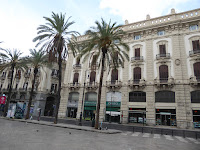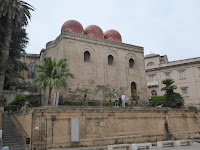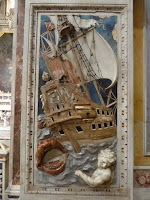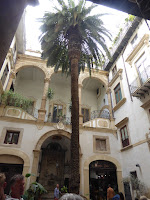 |
| Teatro Massimo |
 |
| Via Roma |
Palermo was a small trading port until the Arabs conquered it in AD 827, and Palermo flourished under Arab rule, becoming Europe’s second largest city (second only to Cordoba) by the 10th century. Subsequently ruled by Normans, the Holy Roman Empire, and Spain, until unified with Italy in 1861, Palermo reflects these different cultures.
 |
| Teatro Massimo stage |
We started our visit with a tour of the famed Teatro Massimo (see exterior picture above), the third-largest opera house in Europe after Paris and Vienna. Completed in 1897, it speaks to the splendor of 19th century Palermo, and is a stunning building both inside and out.
 |
| San Domenico |
Palermo is famous for its street markets. The Capo and Vucciria markets were typical with stalls selling fish, meat and produce. We made the mistake of walking the larger Ballero Market at lunchtime – it was pure chaos with hundreds of people squeezing between the stalls to by prepared street food and provisions. The Baroque Church of San Domenico is impressive, and situated on a quiet plaza of busy Via Roma.
 |
| San Domenico chapel |
 |
San Domenico nave
|
 |
San Domenico organ
|
 |
| Palazzo Alliata di Pietrargliara |
Across Via Roma and up 50 meters is one of the last remaining stone tower houses, built for security. Palazzo Alliata di Pietraragliara at 14 Via Bandiera dates from 1573.
 |
| La Martorana (left) and San Cataldo (right) |
The Piazza Bellini contains three amazing churches. San Cataldo was built during the transition of the city from Arab to Norman rule in the 12th century, so reflects both with a Norman nave and red Arab domes forming the roof. La Martorana is famed for the gilded mosaics, but was closed the day we visited.
 |
| San Cataldo domes |
 |
| San Cataldo nave |
 |
| Santa Catarina altar |
Santa Caterina is an ornate Baroque church that served as the church for a cloistered convent. The families of the nuns could attend masses on religious holidays, but the nuns would stay hidden behind golden screens. There are unique detailed inlaid marble depictions of biblical stories on the pillars, for example Jonah and the whale and Abraham about to slay his son Isaac.
 |
| Santa Catarina ceiling |
 |
| Abraham inlaid marble |
 |
| Jonah inlaid marble |
 |
| Fountain of Shame |
Outside Santa Caterina, Piazza Pretoria is dominated by the Fountain of Shame, so called for the nude statues surrounding the fountain.
 |
| Quattro Canti |
Nearby, at the main intersection in Palermo, each of the four corners (“Quattro Canti”) has an ornate concave façade with sculptures of women representing the four seasons, from a young girl holding flowers representing Sprig, to an old woman representing Winter. As the sun traverses the sky, it first illuminates the Spring corner at dusk, then Summer, Autumn, and finally Winter at sunset.
 |
| Palermo Cathedral |
Palermo Cathedral is absolutely immense. Construction was begun on 1168, but took centuries to complete, thus incorporating influences from different empires that ruled Sicily. Arab and Norman influences are visible outside, including an Arabic inscription from the Quran on one of the entry portico pillars. The nave and ceiling are Gothic, with Baroque chapels. The body of Palermo’s patron saint Santa Rosalia are preserved in an ornate silver altar.  |
| Cathedral and Santa Rosalia float |
 |
| Arab inscription |
 |
| Cathedral portico |
 |
| Palermo Cathedral nave |
 |
| Santa Rosalia reliquary |
Leaving the Cathedral, we passed the beautiful Villa Bonanno Park and the Norman Palace. Begun in the 9th century, the palace was extended by successive ruling empires, and the architecture reflects that influence through the centuries.
 |
| Norman Palace (north) |
 |
| Norman Palace (south) |
 |
| Villa Bonanno Park |
My friend Michele Becci lives part-time in Italy, and publishes the outstanding Our Italian Table. If you love Italian food, I highly recommend you check it out. Michele recommended Vossia Cucina Mediteranea restaurant which was excellent. Per her suggestion, we tried the local white Carricante e Catarratto, which was great. Tammy had the Pasta with Sicilian pesto, and I had the delicious Bucatini with Sardines, anchovies, bread crumbs, onion and spices.
 |
| San Lorenze |
 |
Piazza Garrafello, levelled
in WWII and never rebuilt |
 |
| Santa Caterina Cloister |
 |
| Sunset over Sicily |






















































